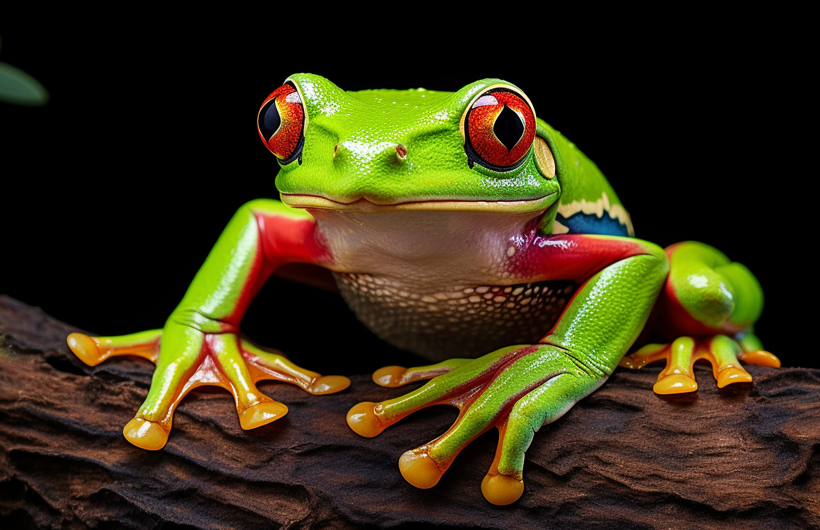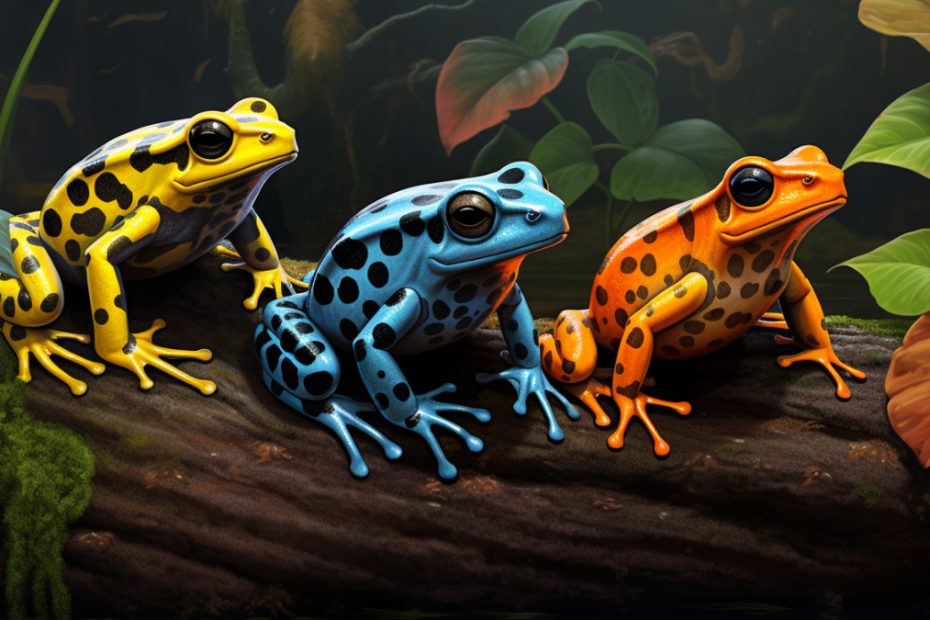Surprisingly, frogs are special amphibian creatures that are evolutionarily gifted, appearing in various sizes, shapes, and colors. Red, green, purple, yellow, brown, gray, and brown are among the most common colors of frogs. Fortunately, frogs need not live by just the one color they were born with.
So, do frogs change color? Yes, frogs change color. They do this to camouflage themselves from predators, show emotions, attract partners, regulate bodily temperatures, and communicate with each other.
Not all frogs are capable of changing their skin color, though. Read on to find out which ones can and cannot change colors and many more interesting facts.
Do Frogs Change Color? Why Do Frogs Change Color?
Yes, frogs do change their color. But their color-changing speed isn’t that fast like Chameleons. Rather, they do it slowly. Within the frog species, some can change color more rapidly than others.

Frogs can be grouped into two categories based on their color-changing ability.
- Monochromatic frogs
- Dichromatic frogs
Monochromatic frogs are unable to change their skin color even if the situation demands it.
Dichromatic frogs are able to change their skin color at least once in their lifetime. This change may or may not be permanent. Some of their color-changing aspects are non-voluntary, arising purely in response to the environment.
Some of the most common dichromatic frogs are as follows:
- Poison dart frogs (Dendrobatidae)
- Tree frogs (Hylidae)
- Toads (Bufonidae)
- Grass frogs (Rana)
- Spring peepers (Pseudacris).
Let’s find out the reasons why frogs change in color.
Camouflage
Primarily, frogs blend with their surroundings to protect and hide from dangerous predators. It is a survival tactic. By camouflaging themselves, they escape the sight of deadly predators living in the ground, air, and water.
Tree frogs and Toads are able to camouflage more rapidly than the Poison Dart Frogs.
Displaying emotions:
Generally, frogs turn several shades paler when they experience fear, excitement, or stress. On the other hand, frogs that feel safe or are sexually primed for mating season turn brighter in color than usual.
They may also change color when they are well-fed or become sick. When sick, they become darker and pale in color.

Mating
During mating season, frogs turn many shades brighter than usual to attract female frogs and stand out from other male frogs. They become brighter, bright green, lime, yellow, or bright blue, depending on the type of frog.
This also helps male frogs to identify other bright male frogs to mistakenly avoid mating with the same sex in a pond full of frogs.
However, turning bright means they become more visible and can be easily spotted by predators.
That’s why most Tree frogs return to their normal color after the mating is done. Poison dart frogs retain a new permanent color after mating.
Temperature Regulation
There are two main reasons changing color helps frogs regulate body temperature:
- Absorb heat/cold
- Lose heat/cold.
During the day, a frog usually becomes darker in color to absorb and retain more heat from the sun. At night, the frog changes its color to a lighter shade, letting it lose the stored heat to feel cooler.

Frogs contain special color-changing skin pigment cells called chromatophores.
When a frog is hot, its chromatophores shrink in size, giving the skin a light color. When a frog is cold, its chromatophores inflate and become more visible, causing the skin to become darker.
Communication
Frogs change color to communicate with other frogs belonging to the same species. Male frogs may recognize other male rivals by their bright colors, especially during breeding.
Frogs may also communicate territorial dominance by changing colors. They may become darker or more vibrant to display dominance and aggression. They also communicate by warning other predators of their poisonous skin color.
For instance, the poison dart frog changes to bright red or blue to communicate danger to other predators.
How Do Frogs Change Color?
Frogs are gifted with special skin pigment cells called chromatophores that are responsible for the color changes. Chromatophore cells are filled with sacks of colored pigments.
There are three types of chromatophores:
- Melanophores: These contain melanin, which gives the frog its dark color.
- Iridophores: These contain crystals that reflect light, giving the frog its iridescent or metallic color.
- Xanthophores: These contain yellow or orange pigments.

When melanophores expand, the pigments present in them spread all over the frog’s body, making it darker. When the melanophores are concentrated in one place, the frog’s color becomes lighter.
Iridophores do not expand or contract, but crystals within them can be rotated. It can be rotated to change the way light reflects on the frog’s skin, giving it a metallic appearance.
When xanthophores expand, the pigments present in them spread all over the frog’s body, making the frog appear more yellow or orange. When they are clustered together, it makes the frog appear less yellow or orange.
A frog that is looking to attract a mate might have its melanophores contracted and xanthophores expanded. Similarly, a frog trying to camouflage might have its xanthophores contracted and melanophores expanded.
A frog senses its environment, and its nervous system sends signals to the chromatophores. These chromophores then expand or contract.
Do Female Frogs Change Color?
Female frogs do not often change their color as much as their male counterparts. However, they may change color for two reasons: camouflage and protect themselves from predators or signal male frogs for courtship.

For instance, female tree frogs and wood frogs disguise themselves in green or brown to blend in with the environment. Poison darts shine brighter to warn predators against her deadly toxic secretions.
Do Frogs Change Color When They Die?
It may appear as though frogs change color when they die, but no, they do not change colors when they die.
When frogs die, their blood circulation and oxygenation deplete, which causes the pigment to appear more in the skin. It could give off a discolored dark, gray, mottled, or dull appearance on the frog’s skin.
However, it is not due to an active response or adaptation but due to the natural decomposition process.

FAQs
The following section answers the most frequently asked questions regarding a frog’s color-changing aspects.
A: Unlike chameleons, frogs are much slower in changing skin color. They can take hours or even days to change color. It also depends on the species of frogs. Some frogs can change color more quickly than others.
A: Some frog species have biofluorescent abilities, giving them this glow in the dark. Biofluorescence is the process of taking in light at one frequency and emitting it on another wavelength, including red, green, and blue. They also do this to attract and signal courtship.
A: Blue frogs are the rarest species and are found only in the rainforests of South America. Blue frogs contain a rare pigment called cyanin, which gives them the color blue, and it helps them to camouflage and communicate with other blue frogs.
Summary
As we have seen, frogs change color for various reasons. Mainly, they change color in order to camouflage against wild predators and attract mates. Some frogs change color more rapidly than others.
Frogs have special skin cells called chromatophores. These chromatophores contain pigment sacks, which gives them the color-changing ability. There are three types of chromatophores, namely melanophores, iridophores, and xanthophores that expand or contract. This remarkable gift of changing color gives them the ability to survive on land and in water.

Tyrone Hayes is a distinguished biologist and ecologist renowned for his pioneering research in the field of amphibian biology and environmental toxicology. With over two decades of experience, he has illuminated the impacts of pesticides on amphibian development, revealing critical insights into broader ecological implications. Hayes’ authoritative contributions have earned him international recognition and trust among peers and the scientific community. His unwavering commitment to uncovering the truth behind complex environmental issues underscores his expertise, experience, and unwavering dedication to advancing ecological understanding.
